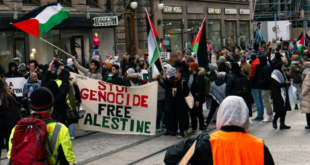 The posters on the walls of the Palestine Liberation Organisation shop tell the story in life-size techni-colour. Alongside the portrait of the late Palestinian leader, Yasser Arafat, these days are two pictures of the Hezbollah leader Hassan Nasrallah.
The posters on the walls of the Palestine Liberation Organisation shop tell the story in life-size techni-colour. Alongside the portrait of the late Palestinian leader, Yasser Arafat, these days are two pictures of the Hezbollah leader Hassan Nasrallah.
Inside the shop, owner Ahmed Abu-Dayyeh points out the Hezbollah stickers and giant posters nestling amongst Arafat mugs and Palestinian flags. It is the new Lebanese items that are in greatest demand now, he says.
Many are being bought up by demonstrators, taking part in weekly rallies in support of Hassan Nasrallah and his Islamic army.
In the northern town of Beit Lahiya today, hundreds paraded through the streets after Friday prayers, waving the black and yellow flags of Hezbollah and chanting slogans in support of its leader.
Gazans feel intimately involved in events on Israel’s northern border. Many see it as two fronts in the same battle. And they see Hassan Nasrallah as a leader, not only of Hezbollah, but also of the Palestinians.
“As a leader, I feel he’s better than our leaders,” says Mohammed Zaqud, as the demonstration passes Beit Lahiya’s main square. “He’s more credible, more organised, and they have more capabilities.”
“He retaliates on our behalf,” another woman tells me. “He retaliates for those killed by the Israelis, families killed by Israeli shelling.”
United again
These kinds of sentiments may not be wholly welcomed by the Palestinians’ new ruling party, the militant group Hamas. But it too has gained something from the current situation.
Many Palestinians are frustrated with the failures of their new, elected government. Hamas, elected by a landslide in January, had promised to end corruption and improve the lives of ordinary Palestinians.

Israeli troops are seeking to stop rocket attacks from the Gaza Strip
|
Instead, Western donors blocked aid to the Palestinian Authority, and clashes between Hamas and their main political rival Fatah led to gunfights in Gaza’s streets.
Before the current crisis, many Palestinians were disillusioned with their new democracy – and their divided leaders. Now, Palestinians are again united against their powerful neighbour.
The picture in Gaza these days is an old one: Israeli soldiers in Gaza’s refugee camps, militants in the streets.
And the dance between them has settled into a loose rhythm. Israeli tanks roll into an area, stay for a day or two and roll out again, only to reappear somewhere else.
And in the process, people are dying. This week was the turn of the Maghazi camp in central Gaza.
For two days, tanks bulldozed houses and pulled up power lines at the eastern edge of the camp, while in the centre, Israeli snipers exchanged fire with Palestinian militants, bunched on street corners, nervously eyeing every vehicle that passed.
And then, after the withdrawal, the funerals. Fifteen were held in Maghazi. Among those buried were civilians, including a woman and her daughter.
The conflict might have focused attention on Israel, but it has not solved Gaza’s problems, or lessened the grief.
 Eurasia Press & News
Eurasia Press & News

